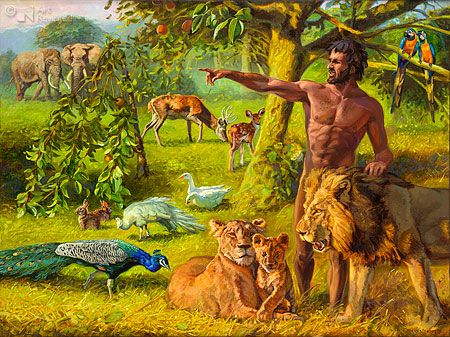
The Mystery of Who Taught Adam to Speak Revealed
Because we take speech for granted, we seldom ask the question when and how did humans began to speak? To fully appreciate the answer, we need to consider the hypothetical ways man may have learned to communicate verses the Biblical account.

First, we will examine the idea that because animals communicate, man simply followed by example. So, do animals actually talk to one another? We know that they can make warnings signals that are clearly understood by others of their species. However, research clearly shows that animals are not self-conscious and therefore can only utter signals and not complex expressions of thoughts or emotions. Instead, these sounds are produced involuntarily like the Oh or Ah when a person is suddenly surprised, or emotionally moved. This simple yet immediate verbalization response from humans is faster than an actual word can be formulated and vocalized. But this response is the only and limited form of animal communication. For example, a dog may whine in anticipation of receiving a treat, but this sound is not the dog’s mind expressing a thoughtful idea. Instead, it is only a reflex response to the feeling of hunger. In other words, the dog is not consciously expressing an emotion. Instead, the innate emotion is expressing itself. The leader of a herd is not the leader because the herd members appreciate its leadership skills. Instead, the leader reigns as the dominate male brought about by hormonal discharges that cause it to drive off or dominate other males. Thus, animal leadership is strictly a biological and instinctual process with the females and their young following whatever male animal ends up in the dominant position.
We must therefore differentiate between sounds produced as involuntary reactions verses sounds or actions thoughtfully produced that express symbolic meanings. The ability to produce sound is shared by most living creatures. Both animals and man can produce simple sounds as signs such as a yell denoting danger or to locate one another. In fact, man is the only creature capable of producing all the sounds made by all animals. Vocalizing a sign is not the same as vocalizing a language but just a simple instinctual survival mechanism. Only man is capable of communicating complex thoughts through the use of sounds that represent symbols or what we know as language.

Human language begins when an infant becomes aware that certain sounds made by a person serve as symbols to others. It is then that the infant begins to deliberately mimic sounds in an attempt to convey its needs, and is rewarded for its efforts by having those needs met. These needs start off very simple; such as hunger, being uncomfortable, frightened or simply a need for attention. But even in expressing these most primitive of needs, the child quickly learns that meaning is attached to certain sounds that it vocalizes. The ability to connect complex meanings to sounds is the giant leap within the human thought process that animals, because of inherent brain structures, are incapable of achieving. So, speech starts when the infant instinctually cries and recognizes that it receives a response. The infant quickly becomes self-aware of its relationship to others because its unique human brain structure allows this type of complex cognitive sound response processing.
An animal is incapable of becoming self-aware. It may bare its teeth when frightened making it seem fierce but this is an instinctual reaction to fear that automatically cause this response. Most animals are limited to three reactions concerning any situation. It can run, it can stand its ground and fight, or it can become submissive. But any of these three reactions is purely instinctually based on hormones and not an awareness of the various more subtle courses of actions available. Survival is completely based on signs with no symbolic consciousness.

Pet owners would beg to differ with this conclusion based on the relationship they have with their animals. While the reactions of their pets to stimuli are noticeably different in expression from those of wild animals, this is only due to the work of breeders. For thousands of years, breeders have been skillfully and judiciously breeding males that exhibit seemingly human character traits to females that exhibit these same traits. Thus, the offspring can reasonably appear almost human. But, these traits are only instinctual by way of breeding in order to make the animal’s behaviors more appreciated by its human owner. The animal is still running on instincts albeit much more genetically refined to please the owner. When a person says that their dog acts almost human, this is true. But the key in understating the action of these animals is in the word acts. The truth is, the animals basic brain structure is hardwired. So, while a pet may seem to intellectually second guess its owner, this should not be confused with the animal having cognitive awareness. This arduous select breeding is why some of the so called intelligent breeds cost so much more than breeds that are somewhat dull and lumbering yet still very loveable.

The crucial point is that humans can express themselves propositionally through symbolic language while animals can only express themselves instinctually through signs. Animals cannot cognitively progress from subjective thought to objective thought, from affective signs to propositional symbolic language. For example, experiments with apes show that their communication skills are also limited to instinctive signs. New born apes have been removed from their mothers with no contact from other apes. Then, after five years, the apes have been reunited with their relatives. The isolated apes have no problem immediately communicating with the others. And, they continue to make gestures even when no other animals or people are around. Animals will respond to their surroundings through sounds and movements, but human responses are much more complex and nuanced. They have individual words for individual degrees of feelings and thoughts. And, they can combine these words to make complex sentences.

Now let us consider the evolutionary theory of how speech was created. This theory is taught in educational institutions and is based on a scientific construct of attained knowledge concerning natural, observable and quantitative phenomenon and not on the belief of a supernatural Creator. This theory reasons that everything began in a primitive chaotic form that progressed in an ordered sequence from simple to complex. In this case, it is theorized that language started as a series of grunts and clicks accompanied by perhaps facial gestures. However, studies concerning the languages of the most primitive cultures reveal that these languages are exceedingly complex. They are so much more complex than today’s languages that there is evidence that primitive people may not even reason in the simplistic ways of so called modern man. In other words, it is not the idea of higher verses lower mental capacities but instead, different ways of conceiving reality. People with the least complex cultures typically have the most sophisticated languages. Primitive languages are perceived by the public as lacking a vocabulary large enough to effectively communicate when in fact, the exact opposite is true. The problem is that the translator is forced to dumb down the complex thought expressed by the speaker to make it intelligible to the modern listener. A translator will tell you that a primitive language is much more difficult to learn than that of so called modern language. Primitive languages have large varieties of words to express nuances concerning a subject whereas modern languages have much fewer homogenized words (Lenneberg, Eric, The Biological Foundations of Language, Whiley, 1967, pg. 264).
For example, in the Arabic language, there are no less than five to six thousand terms used to describe a camel. Each word depends on the exact size, shape, color, age and gate of the animal. Native Americans have many words when it comes to a blow to the body. The correct word to be used depends on the power and where exactly the blow landed on the body. Tribes in the tropics have hundreds of words concerning parrots but not the actual homogenized word parrot that encapsulates the entire species. Peru has two hundred and nine distinct words for potato and the indigenous people of Alaska have an unlimited number of names for snow and ice yet not a single word for just snow.

Next is the question of whether speech is instinctive or learned. This question was answered long ago by way of observing wild or feral children. It has been documented on numerous occasions that very young children left isolated and alone in a wilderness setting, when discovered, do not talk nor can they be taught to talk beyond the level of a three or four year old. In one case, two very young children were left in a wilderness setting and when found, neither one was able to communicate with the other. In other words, they did not instinctually work out a verbal communication system between themselves. They had the brain structure and vocal apparatus to speak but actually speaking was not instinctual.
Now let’s examine the idea that animals were the first to communicate to one another followed by man. And, if animals can speak to each other, is their speech comparable to mans and can humans teach animals to speak? The vocal anatomy of the higher apes are not basically different from man so they ought to be able to speak as we do. While parrots can be taught to mimic speech, apes and monkeys cannot be taught to vocalize a thought. This has caused evolutionary theorists to question the idea that language evolved because again, the basic vocal apparatus of the human voice is found in some animals yet they cannot vocalize words in order to share a thought. Thus, the ability to speak must be a unique structure only found in the human brain.
We also know that although humans have a vocal mechanism and the brain structure necessary to speak, humans cannot automatically speak. This means that the ability for a person to speak requires the presence of another person to teach the person to speak. And while feral children were eventually taught to vocalize a few simple words, none were ever able to converse in simple sentences. In other words, a person must be taught to speak at a very young age by another person. So, this time sensitive necessity poses a question that science cannot answer. How it is possible that this learned skill could have been taught to a person without the existence of another person to teach this skill?

In the Book Genesis, we constantly read the phrase, “God said….” which is always followed by a physical reaction initiated by His spoken Word. In Chapter One, God initially gives five separate commands on five separate days. Then the narrative suddenly changes from a series of brief straightforward commands to a private conversation. And, this conversation is taking place in Heaven between God and at least one other entity concerning the creation of man. It is clear that God is not pondering the creation of man out loud with the heavenly host of created angelic beings. He is instead speaking directly to another entity concerning an understanding and agreement involving the act of creating man. And, the conversation ends with an agreement that the man would, in certain ways, be made in the image of his Creator. In other words, man would be given an intellect that would have some instinctual reactions like the animals, but also have the unique ability to contemplate existence, the world in which he was created and to recognize and communicate with his Creator. All this was encapsulated in the simple phrase, “Let Us make man in Our image, after our likeness:" (Genesis 1:26-28). God makes it clear that He was talking to another companion being and declaring that together, they would be involved in creating a physical, mortal being that would resemble in some ways both their image or countenance and spiritual likeness of his Creator. Thus, Man was not made in the spiritual image nor likeness of the angels nor the physical image of the animals. Man was, from the beginning, a combination of the spiritual image of God which means that He was endowed with an immortal spirt in some ways like God. But also, He was made a physical being like the animals with both instinctual and intellectual abilities. This meant that He was able to live in a physical world yet converse with his spiritual Creator.
So, when God said, “Let Us make man in Our image …" He was not addressing this idea to the angels. Instead, He was speaking to another entity. And, this would explain why the name of God in Hebrew is in the plural form. We later learn from Scripture that God intentionally revealed to us that He is both singular and yet plural. He exist both outside and within the physical laws of nature. That He consists of three unique yet inextricably intertwined entities in complete and serene oneness with each other. And while they communicate with each other, they are always in complete agreement with each other. This seeming contradiction of three completely separate entities completely unified in their eternal existence is referred to as the Triune Godhead. The Godhead consist of God the Father or the Creator, God the Word who speaks on behalf of the Godhead, and God the Holy Spirit who causes a command to be actualized. So, while we refer to the one true Creator God, He is at the same time, three entities with no contradiction in their singularity of existence. And it is this single yet pluralistic entity that is speaking to one another on behalf of itself. If this concept is hard to conceptualized, this would be appropriate as God is not of nature and the depths of a full contemplation and appreciation of Him is currently beyond the capacities of the human mind (Isaiah 55:8-9; Romans 11:33). Thus, the word awesome can only be fully realized when referring to God.

So, we now know that it was God the Word that spoke creation into existence (John 1:1-4). And rightly, it was God the Word that was the first to speak to His first created man Adam. It was when the Word of God began to speak to Adam, that he heard his first words and thus the beginning of a glossary of words. It would be from this vocabulary foundation that Adam would be able to accomplish God’s desire for man to be able to commune with Him. And this would also allow Adam to fulfill God's command for him to name the objects of creation around him (Genesis 2:19-20). This command was by necessity a basic object lesson because any other person Adam might meet would need to hear and learn these same words in order for them to communicate with each other. And, it is this unique ability to share knowledge that separates mankind from the animals.
The first words in Genesis simply state that, “In the beginning, God created the heavens and the earth” (Genesis 1:1) So, we have the word God, then the word created, then the word heavens and the word earth. Because God created Adam, He understood that upon becoming conscious, Adam would immediately understand that he exists as a self contained creature, and will want to know who he is, where he is and how did he come to exist. So, God starts by telling him that He created him after He created the heavens and the Earth in which he now finds himself. That He created all things from nothing and man from the earth on which he will now live. The earth is below him and the sky or heaven is above him. God will personally name the Earth (Genesis 1:10). All other planetary bodies were given their pagan names by man. These are the first and most foundational and rudimentary words and concepts upon which Adam will build a more complex vocabulary. And this vocabulary will quickly grow so as to convey the incredibly complex mental constructs of which he is capable.These capacities are available to Adam because he, and he alone, was created in the image of God. This learned ability to speak was, according to the Bible, taught to Adam by the Word of God who was a pre incarnation of Christ (Genesis 2:16, 20, 23).
Adam is now given his own name which literally meant man. But, figuratively Adam was named because from the beginning, he was destined to create a population of people (Genesis 5:2). Thus, he and his children would all need names to maintain a cohesive society. Adam is now allowed and encouraged to speak for himself. God had given oversight or governance of the animals to Adam so it was only right that Adam be the one to name the animals to his liking. In personally giving them a name, he took on the responsibility to look after them. Scripture simply states that whatever Adam named an animal, that was to be its name (Genesis 2:20).

We are not told how Adam decided on a name. He might have decided based on size, color, shape or the sound they made. And, since Adam was the only physical creature created in God’s image, he alone was allowed the right to rule over the animals. It was by allowing Adam to look at, consider and name the animals that it became apparent to him that he did not have a mate like the animals. God did this because he wanted Adam to internalize this knowledge and desire a mate. A gift is more precious when it longed for. God watched and waited for Adam to understand that he could not be whole without a compliment. Adam had patiently waited in anticipation for his compliment to eventually arrive while naming the animals that wandered into and out of the garden. But each day he was continuously disappointed that no creation similar to him came to him to be recognized and named. This unmet desire frustrated him and caused him to become depressed as none of the lower animal life forms provided suitable companionship to alleviate his growing loneliness.

God closely monitored this process until it became clear that Adam was now ready to fully appreciate a female companion. God first caused Adam to sleep, thus the first act of anesthesia. God then reaches into the side of Adam, thus the first surgery. He extracts a sample of DNA, thus the first cloning process (Genesis 2:22). Scripture tells us that Adam was formed or molded from the soil or clay of the earth. God then breathed both life and an eternal spirit into him (Genesis 2:7). He then brought Adam to the Garden He had planted especially for him, to satisfy all his dietary and security needs (Genesis 2:8). However, scripture tells us God built Eve in the garden while Adam slept. When Adam awoke, he probably though he would continue the animal naming process, but he immediately realized that God had removed some of his flesh. He looked up and saw the Word of God walking Eve up to the place where Adam now stood. It was then that Christ introduced the two and performed the first marriage ceremony. Adam apparently knew what was happening, and immediately spoke the first compound sentence recorded in the Bible (Genesis 2:23-24).
This story is both simply written yet profound in the amount of information given and implied for the reader to understand. Here we have the first man created especially by God in a specific location for a specific purpose. The first woman was created in a different location for a different purpose. The two meet in a garden, the original Temple of God, and the first marriage ceremony was conducted by the Word of God. Jesus would revisit this moment when He attended a marriage in Cana. There He performed His first miracle by turning water into wine. By dong this He showed He had the power to change existing properties on a molecular level. And, because the wine He created was aged so as to be considered of the finest quality, he also showed He had power over time itself (John 2: 7-10). In the raising of Lazareth, He would show He had to power to create life as He did with Adam and Eve. And with His resurrection, He showed He had the power to bestow immortality to mankind.
Adam named Eve and began to teach her the words he was taught by God along with the words he had invented concerning the world around him. Eve would have eagerly learned these words and the two slowly began their first conversations. Adam apparently taught Eve about how they came to exist and where they lived as was explained to him each day by God the Word. He also told her about the Tree of Knowledge and why they were forbidden to eat it's fruit (Genesis 3:2-3).

The Jews believe that Moses wrote the first five Books of the Bible. However, it was Adam who first dictated the creation story to Methuselah who passed it down to his grandson Noah. Noah then passed the story down to Abraham. God could have also personally related the story to Moses. But Moses had no doubt also heard it from his parents. The story that Moses wrote is both extremely simple yet filled with complex actions and reactions. And, it is the only story of creation that does not involve a pantheon of flawed gods, mythological creatures or a theory that man evolved from a one cell Amoeba. In fact, the Biblical creation account concerning the sequence of created life forms is exactly in line with the major sequences of life as taught using the evolution theory.
So, language is taught starting in infancy with little effort required to learn on the part of the child. The physical apparatus that allows mankind to speak is automatically in place, but using this ability to speak comes from hearing, observing the effect words have on others, then mimicking those words to achieve the desired response. But, it is clear that the infant must have a teacher to learn how to speak. Without a teacher, there is absolutely no way a child will learn on its own by way of instinct, how to verbalize a statement in order to convey a thought.
Not only do we learn from the Bible that it was God that taught Adam to speak, we know that physiologically, all people still need to be taught by someone to speak. This understanding was fundamentally necessary for Adam and still holds true to this very day. This also helps explain how is it that all mankind throughout the world possess complex languages. And while the various races of the world have uniquely developed skill sets in music, visual arts, clothing, culinary arts, pottery, etc., language is both present and highly developed in all of them.
Thus, the Biblical record on this ability appears to be the only logical explanation on which we may rely. It was God, or more precisely, the Word of God that first spoke to Adam when he became conscious immediately after being created. And because Adam was the first man created, he was genetically the most perfect man ever created. Thus, his intellectual capacities must have been extraordinarily acute. Adam no doubt had a photographic memory and an unending thirst to learn in order to better converse with his Creator. And this ability to directly communicate with God is a unique privilege that only mankind has been granted. God specifically created mankind in His image so that He could commune with them, love them, be loved in return and start a family. Without fellowship with God, a person is much like the feral child orphaned and alone in a world filled with beauty and mystery but also solitude. To communicate with others is necessary for optimum physical, emotional, intellectual and social growth. But most importantly, to commune with God is the only path to Spiritual growth, which is the true meaning of life. Spiritual growth is the only growth that gives life meaning and causes a person to be fully alive and to fully appreciate this life and the one to come.
If you enjoy the information provided on this site, please consider making a donation of any amount to help continue its production. Donate Now